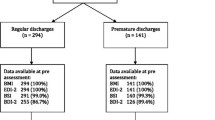Summary
A staged program for inpatient treatment of anorexia nervosa is presented. This program integrates behaviour-therapeutic and interactional models. Results show that five of seven patients completed the program successfully and maintained their stable condition after an average catamnestic period of 16 months. The necessity of integrating both models and the practical difficulties in a clinical setting are discussed.
Zusammenfassung
Es wird über ein gestuftes stationäres Behandlungskonzept der Anorexia nervosa berichtet, das verhaltenstherapeutische und kommunikationstheoretische Ansätze integriert. Die Ergebnisse zeigen, daß 5 von 7 Patientinnen das Therapieprogramm erfolgreich abschlössen und auch nach einem Katamnesezeitraum von durchschnittlich 16 Monaten den Therapieerfolg beibehielten. Auf die Notwendigkeit der Integration, aber auch auf die Schwierigkeiten der Durchführbarkeit eines verhaltenstherapeutischen Behandlungskonzeptes im Rahmen stationärer Krankenhausversorgung wird hingewiesen.
Similar content being viewed by others
Literatur
Agras WS, Barlow DN, Chapin HN (1974) Behavior modification of anorexia nervosa. Arch Gen Psychiatry 30:279–286
Agras St, Werne J (1977) Behavior modification in anorexia nervosa: Research foundations. In: Vigersky RA (ed) Anorexia nervosa. Raven Press, New York
Allyton T, Haughton E, Osmond HO (1964) Chronic anorexia: A behavior problem. Can Psychiat Ass J 9:147–154
Ashby WR (1974) Einführung in die Kybernetik. Suhrkamp, Frankfurt
Bachrach AJ, Erwin WJ, Mohr PJ (1965) The control of eating behavior in an anorexic by operant conditioning techniques. In: Ullmann LP, Krasner L (eds) Case studies in behavior modification. Holt, New York, pp 153–163
Blinder BJ, Freemann CM, Stunkard AJ (1970) Behavior therapy of anorexia nervosa: Effectiveness of activity as reinforcer of weight gain. Am J Psychiatry 126:1093–1098
Bruch H (1973) Eating disorders. Basic Books, New York
Elkin TE, Hersen M, Eislar RM, Williams JG (1973) Modification of caloric intake in anorexia nervosa: An experimental analysis. Psychol Rep 32:75–78
Fahrenberg J, Selg H, Hampel R (1973) Das Freiburger Persönlichkeitsinventar (FPI). Hogrefe, Göttingen
Fichter MM, Wüschner-Stockheim M (1979) Die Pubertätsmagersucht: Symptomatik, Verlauf und Behandlungsmöglichkeiten. Päd Praxis 22:411–422
Frahm H (1965) Ergebnisse einer systematisch durchgeführten somatisch orientierten Behandlungsform bei Kranken mit Anorexia nervosa: In: Meyer JE, Feldmann H (Hrsg) Anorexia nervosa. Thieme, Stuttgart
Frahm H (1973) Anorexia nervosa. In: Hornbostel H et al (Hrsg) Innere Medizin in Praxis und Klinik IV. Thieme, Stuttgart, pp 13–19
Garfinkel PE, Moldofky H, Garner DM (1977) The outcome of anorexia nervosa: Significance of clinical features, body image and behavior modification. Can Med Ass J 117:1041–1045
Gensicke P (1976) Zur Klinik, Psychopathologie und Familienstruktur der Anorexia nervosa. Med Diss, Göttingen
Gensicke P (1979) Anorexia nervosa — ein familiales Sozialisationsdefizit? Z Psychosom Med 25:201–215
Hautzinger M (1978) Anorexia nervosa. Psycho 4:414–419
Kehrer HE (1972) Behandlung der Pubertätsmagersucht mit Verhaltenstherapie. Nervenarzt 43:129–136
Kehrer HE (1975) Behandlung der Anorexia nervosa mit Verhaltenstherapie. Med Klinik 70:427–432
Lazarus AA (1978) Multimodale Verhaltenstherapie. Fachbuchhandlung für Psychologie, Frankfurt
Leitenberg H, Agras WS, Thomson LE (1968) A sequential analysis of the effect of selective positive reinforcement in modifying anorexia nervosa. Behav Res Ther 6:21–218
Liebmann R, Minuchin S, Baker L (1974) An integrated treatment program for anorexia nervosa. Am J Psychiatry 131:432–436
Meermann R (1979) Verhaltenstherapie bei Anorexia nervosa: Eine Literaturübersicht. Psychother Med Psychol 29:184–195
Meitinger H, Heil M (1979) Familientherapie in der Verhaltenstherapie. Z Kinder-Jugendpsychiatr 7:353–361
Meyer JE (1961) Das Syndrom der Anorexia nervosa: Katamnestische Untersuchungen. Arch Psychiat Nervenkr 202:31–59
Meyer JE (1972) Psychopathologie und Klinik des Jugendalters, Pubertät und Adoleszenz. In: Kisker KP et al (Hrsg) Psychiatrie der Gegenwart, Bd 2. Springer, New York
Meyer JE, Feldmann H (Hrsg) (1965) Anorexia nervosa. Thieme, Stuttgart
Minuchin S (1974) Families and family therapy. Harvard Univ Press, Cambridge Mass u London
Minuchin S, Rosmann BL, Baker L (1979) Psychosomatic families. Anorexia nervosa in context. Harvard Univ Press, Cambridge Mass u London
Schaefer K, Schwarz D (1974) Verhaltenstherapeutische Ansätze für die Anorexia nervosa. Z Klin Psychol Psychother 22:267–284
Schnurer AT, Rubin RR, Roy A (1973) Systematic desensitization of anorexia nervosa seen as a weight phobia. J Behav Ther Exp Psychiat 4:149–153
Selvini Palazzoli M, Boscolo L, Chechin G, Prata G (1977) Paradoxon und Gegenparadoxon. Klett, Stuttgart
Selvini Palazzoli M (1974) Self-starvation. Chaucer, London
Sperling E, Massing A (1970) Der familiäre Hintergrund der Anorexia nervosa und die sich daraus ergebenden therapeutischen Schwierigkeiten. Z Psychosom Med 16:130–141
Sperling E, Massing A (1972) Besonderheiten in der Behandlung der Magersuchtsfamilie. Psyche 26:357–369
Thomä H (1961) Anorexia nervosa. Huber, Bern
Vigersky RA (ed) (1977) Anorexia nervosa. Raven Press, New York
Watzlawick P, Beavin JH, Jackson DD (1974) Menschliche Kommunikation: Formen, Störungen, Paradoxien. Huber, Bern
Zerssen D v (1976) Klinische Selbstbeurteilungs-Skalen (KSb-S) aus dem Münchener Psychiatrischen Informations-System (Psychis, München). Beltz, Weinheim
Author information
Authors and Affiliations
Rights and permissions
About this article
Cite this article
Brand, J., Gensicke, P. Ein verhaltenstherapeutisch-kommunikationstheoretisches Konzept zur stationären Behandlung der Anorexia nervosa. Arch. Psychiat. Nervenkr. 229, 113–126 (1980). https://doi.org/10.1007/BF00343077
Received:
Issue Date:
DOI: https://doi.org/10.1007/BF00343077




